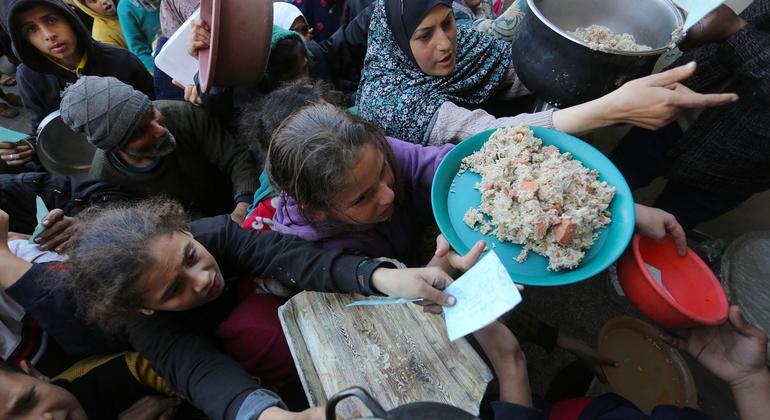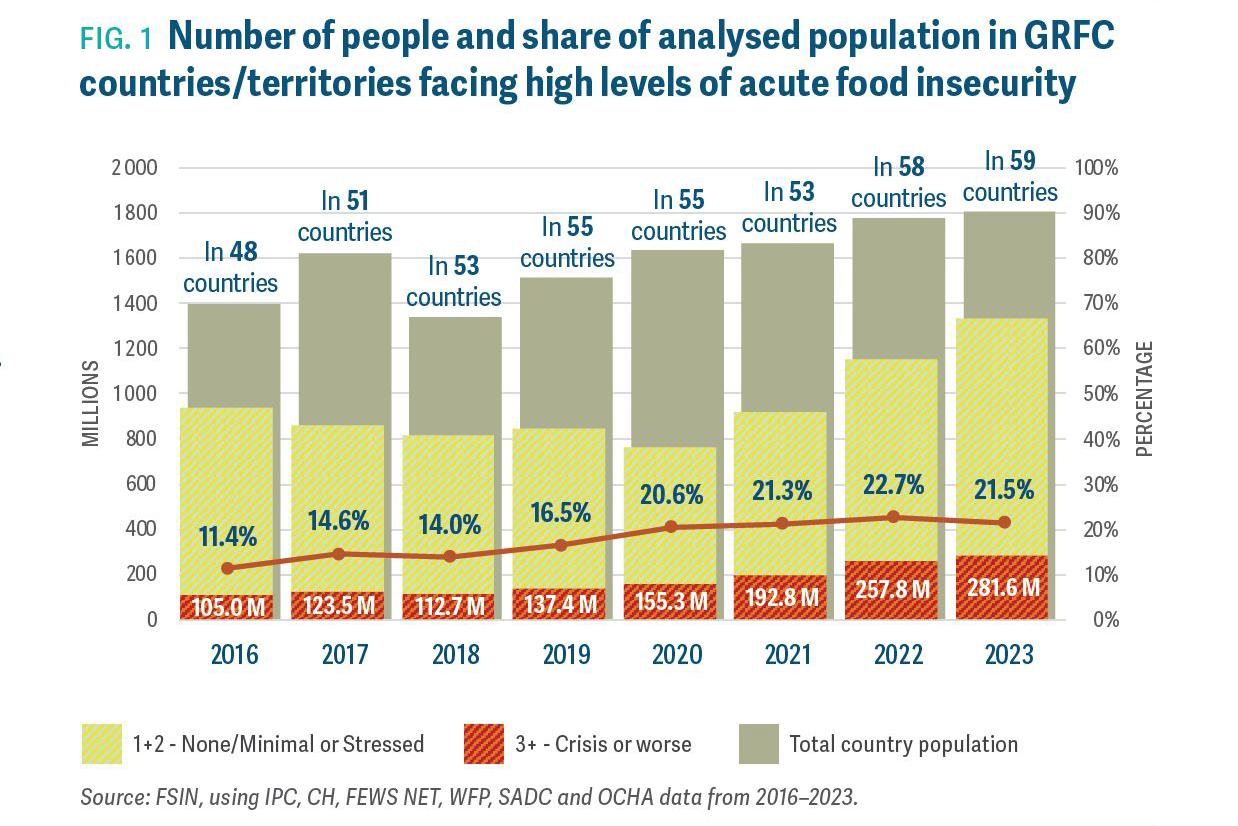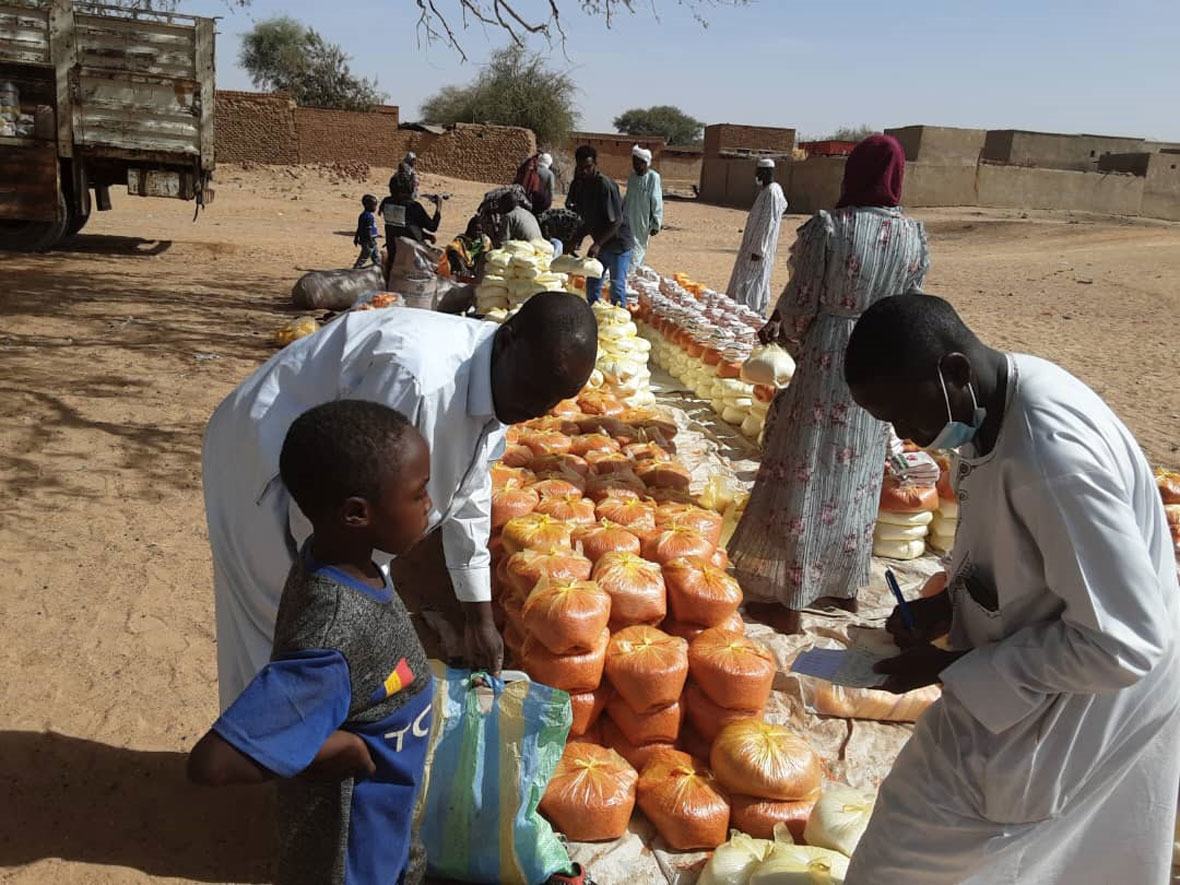Famine Risk Highlighted in Gaza, Sudan, and Beyond: New Hunger Data Reveals Alarming Trends
 Dangerous levels of acute hunger affected a staggering 281.6 million people last year – the fifth year in a row that food insecurity has worsened – heightening growing fears of famine and “widespread death” from Gaza to Sudan and beyond, UN agencies warned on Wednesday.
Dangerous levels of acute hunger affected a staggering 281.6 million people last year – the fifth year in a row that food insecurity has worsened – heightening growing fears of famine and “widespread death” from Gaza to Sudan and beyond, UN agencies warned on Wednesday.
According to the latest Global Report on Food Crises, more than one in five people in 59 countries faced acute food insecurity in 2023, compared with around just one in 10 in 48 countries in 2016.
“When we talk about acute food insecurity, we are talking about hunger so severe that it poses an immediate threat to people’s livelihoods and lives. This is hunger that threatens, to slide into famine and cause widespread death,” said Dominique Burgeon, Director of the UN Food and Agriculture Organization (FAO) Liaison Office in Geneva.
COVID-19 threshold
The report – a joint initiative involving FAO, the UN World Food Programme (WFP) and the UN Children’s Fund (UNICEF) – found that although the overall percentage of people defined as dangerously food insecure last year was 1.2 per cent lower than in 2022, the problem has worsened significantly since the COVID-19 crisis.
When the coronavirus hit in late 2019, around one in six people in 55 countries faced worrying food insecurity levels, compared with one in five just a year later, the Global Report on Food Crises indicates.

FSIN, using IPC, CH, FEWS NET, WFP, SADC and OCHA data
Global Report on Food Crises 2024: Number of people and share of analysed population in GRFCcountries/territories facing high levels of acute food insecurity
‘People clearly dying of hunger in Gaza’
Food crises have escalated alarmingly in 2023, the report’s authors noted, citing particular concerns over Sudan and Gaza “where people are clearly dying of hunger”, said Gian Carlo Cirri, WFP Director, Geneva office.
After nearly seven months of Israeli bombardment, “people cannot meet even the most basic, food needs, they have exhausted all coping strategies, like eating animal fodder, begging, selling off their belongings to buy food. They are most of the time destitute and clearly some of them are dying of hunger,” Mr. Cirri said.
The only way to halt the famine is to ensure daily deliveries of food supplies “in a very short time”, the WFP official told journalists in Geneva.
“We’ve mentioned the necessity to rebuild livelihoods, to address root causes and so on. But in the immediate time, like tomorrow, we really need to significantly increase our food supplies. This means rolling out massive and consistent food assistance in conditions that allow humanitarian staff and supplies to move freely and (for) affected people to access safely the assistance.”
‘Closer by the day to famine’
The new warning on Gaza is in line with repeated dire assessments from respected food insecurity experts who issued an alert that famine is likely “anytime” between now and May 2024 in northern governorates.
“We are getting closer by the day to a famine situation; malnutrition among children is spreading – we estimate 30 per cent of children below the age of two is now acutely malnourished or wasted and 70 per cent of the population in the north is facing catastrophic hunger,” WFP’s Mr. Cirri said. “There is reasonable evidence that all three famine thresholds – food insecurity, malnutrition, mortality – will be passed in the next six weeks.”
Sudan danger
On Sudan, the UN report noted that 20.3 million people – or 42 per cent of the population – struggled to find enough to eat last year, after conflict erupted in April.
This represents the highest number of people in the world facing “emergency” levels of acute food insecurity – or IPC4 – in line with the Integrated Food Security Phase Classification warning scale, where IPC5 indicates the highest level of danger.
With only a few weeks left before the beginning of the planting season, humanitarian assistance must be allowed immediately inside and across Sudan to avoid any further deterioration of the situation, the report’s authors insisted.

© WFP/World Relief
WFP and its partner World Relief provide emergency food supplies in West Darfur.
“What is very concerning, for us is that the bulk of those people depend on agriculture for their livelihoods. And that, for example, if you take the Al-Jazeera state, this is a critical state, for, food production, it’s about 50 per cent of the wheat production of Sudan that is coming out of state,” said FAO’s Mr. Burgeon.
“It is absolutely critical that wherever it will be possible to access the people (that) we provide them with agricultural inputs on time so that they can plant their fields. If those people fail to plant their fields, it means we have to be prepared for massive, food assistance requirement until the next harvest next year.”
Simon Blake is an experienced journalist deeply interested in international affairs and global development. Having spent years reporting on humanitarian issues, he offers a unique perspective in his coverage of United Nations news.




How can we address the root causes of this worsening food insecurity trend to prevent famine risks from escalating further?
To address the root causes of this worsening food insecurity trend and prevent famine risks from escalating further, a multi-faceted approach is required. This includes investing in sustainable agriculture, addressing climate change impacts, improving access to education and healthcare, promoting income-generating opportunities, and enhancing social protection mechanisms. Collaboration between governments, international organizations, NGOs, and local communities is crucial in developing comprehensive solutions to tackle food insecurity at its core.
Does the article mention any specific actions being taken to address the famine risk in Gaza and Sudan?
Yes, the article mentions that UN agencies have highlighted the alarming trends of acute hunger in Gaza, Sudan, and beyond, and are working to address the famine risk by closely monitoring the situation and providing humanitarian aid to those in need.
As an advocate for humanitarian aid, it’s heartbreaking to see how acute hunger is escalating, posing a grave threat to millions worldwide. The statistics presented in this article underscore the urgency for swift action to prevent the devastating consequences of famine from engulfing vulnerable communities. The joint efforts of organizations like FAO, WFP, and UNICEF are crucial in mitigating this crisis and ensuring food security for all.
As a concerned citizen, I believe urgent action is needed to address the escalating famine risk highlighted in Gaza, Sudan, and beyond. It’s heartbreaking to see the growing numbers of people facing acute hunger, and we must prioritize efforts to prevent widespread death. The findings in the latest Global Report on Food Crises are truly alarming and require immediate attention and support from the international community.
As a journalist, these findings are deeply troubling. The increasing levels of acute hunger and food insecurity in regions like Gaza and Sudan demand urgent attention and action from the international community. We cannot afford to ignore the risk of famine and widespread death looming over millions of lives. It is critical that we come together to address this crisis and prevent further suffering.
As a humanitarian worker in the field, it’s heart-wrenching to see how hunger is escalating year after year. We must take urgent action to prevent famine and save lives in these struggling regions. The world cannot turn a blind eye to this crisis.
As a humanitarian worker with field experience in food insecurity crises, I am deeply concerned about the escalating famine risk highlighted in Gaza, Sudan, and other regions. The alarming trends revealed by the new hunger data emphasize the urgent need for global action to address acute hunger and prevent widespread death. It is crucial that international organizations and governments step up their efforts to ensure food security for vulnerable populations and prevent the devastating consequences of famine.